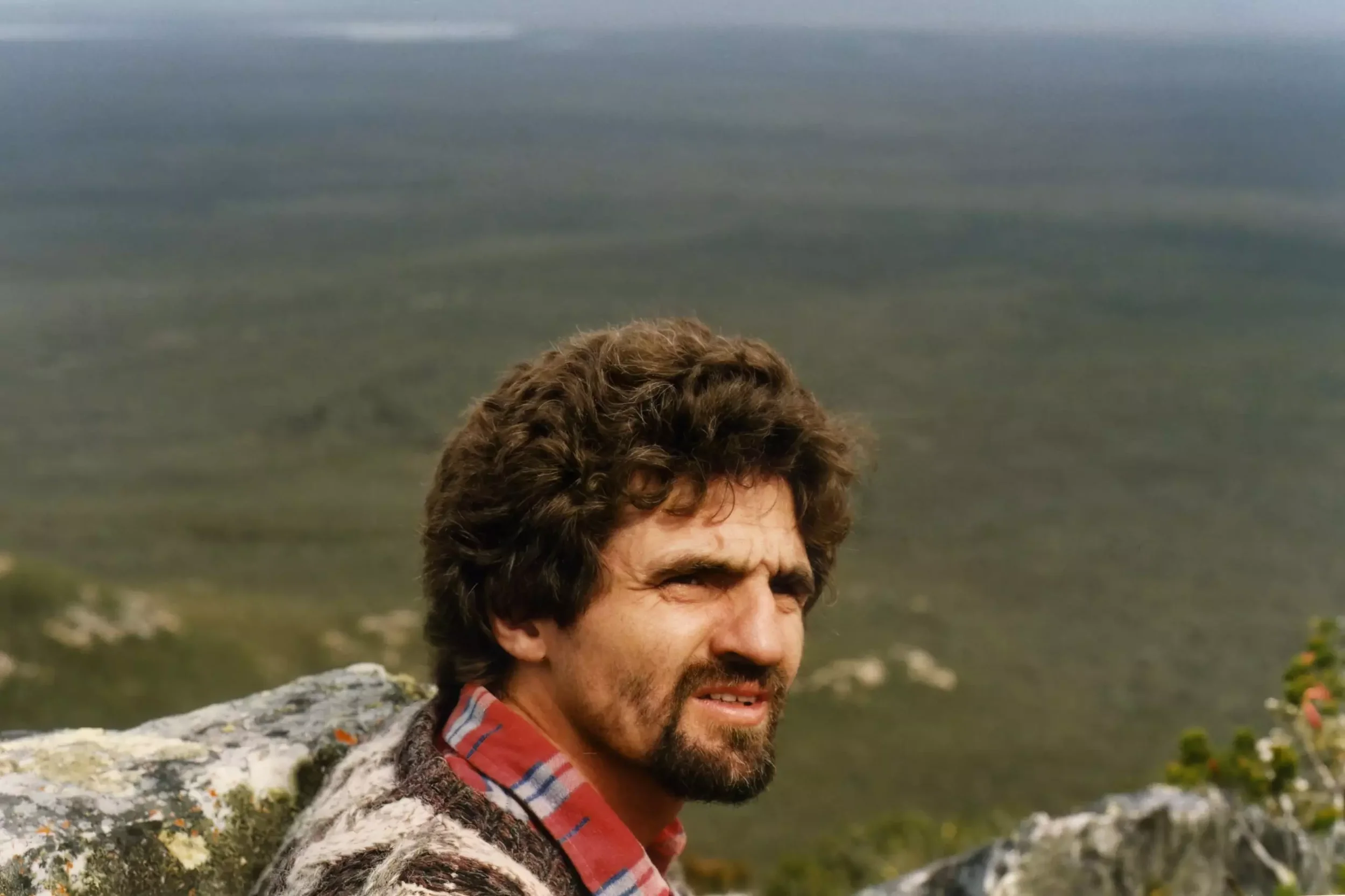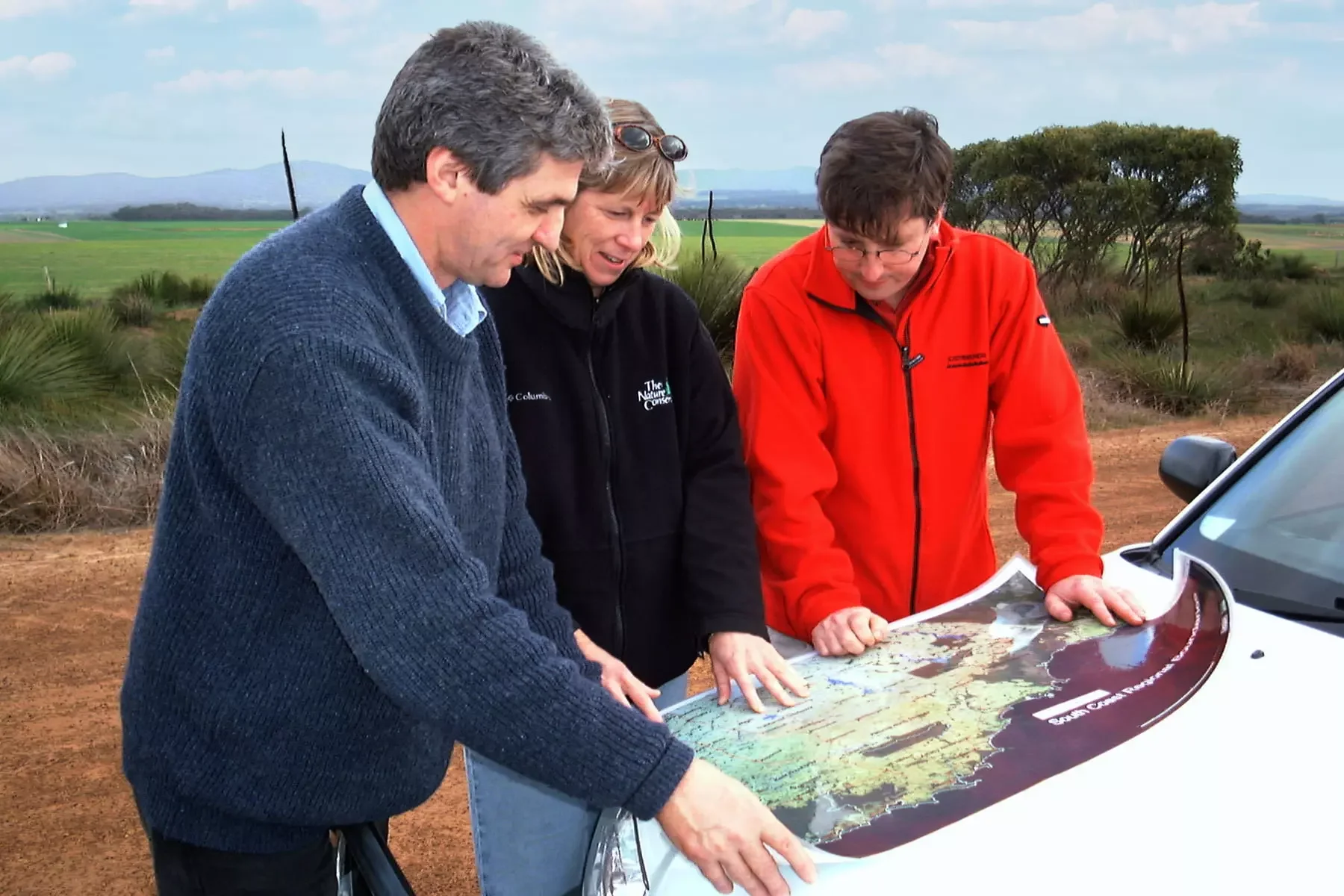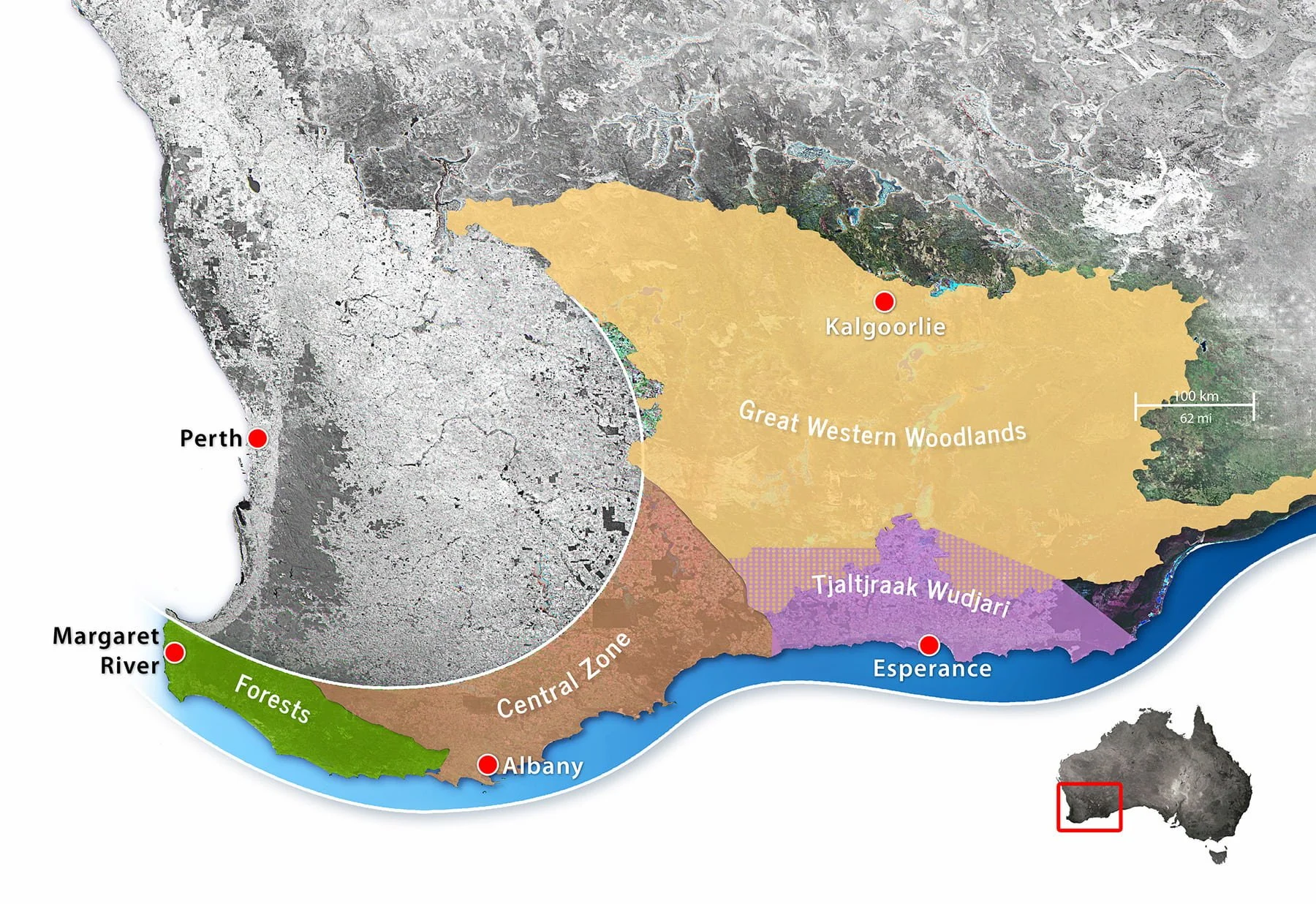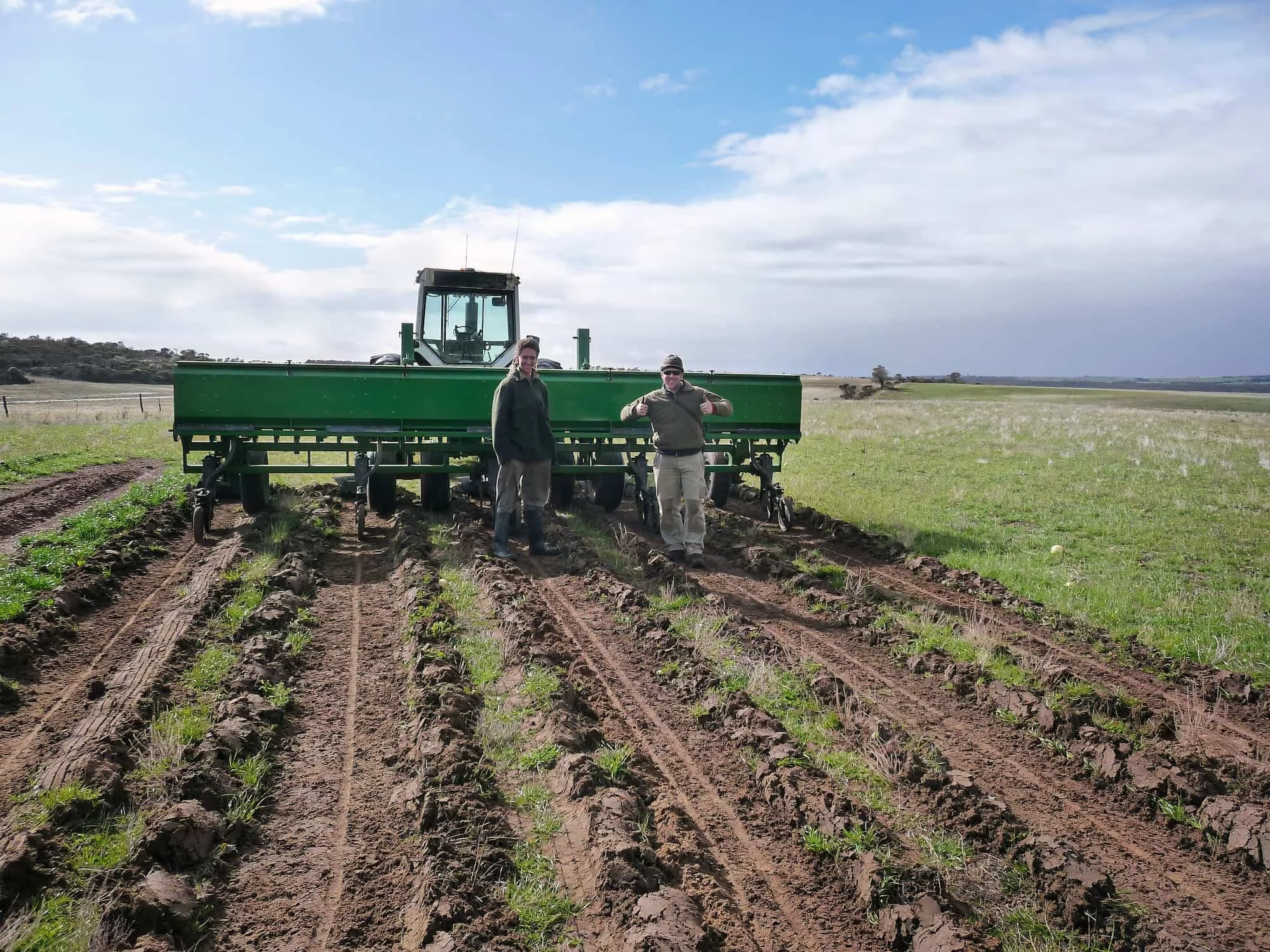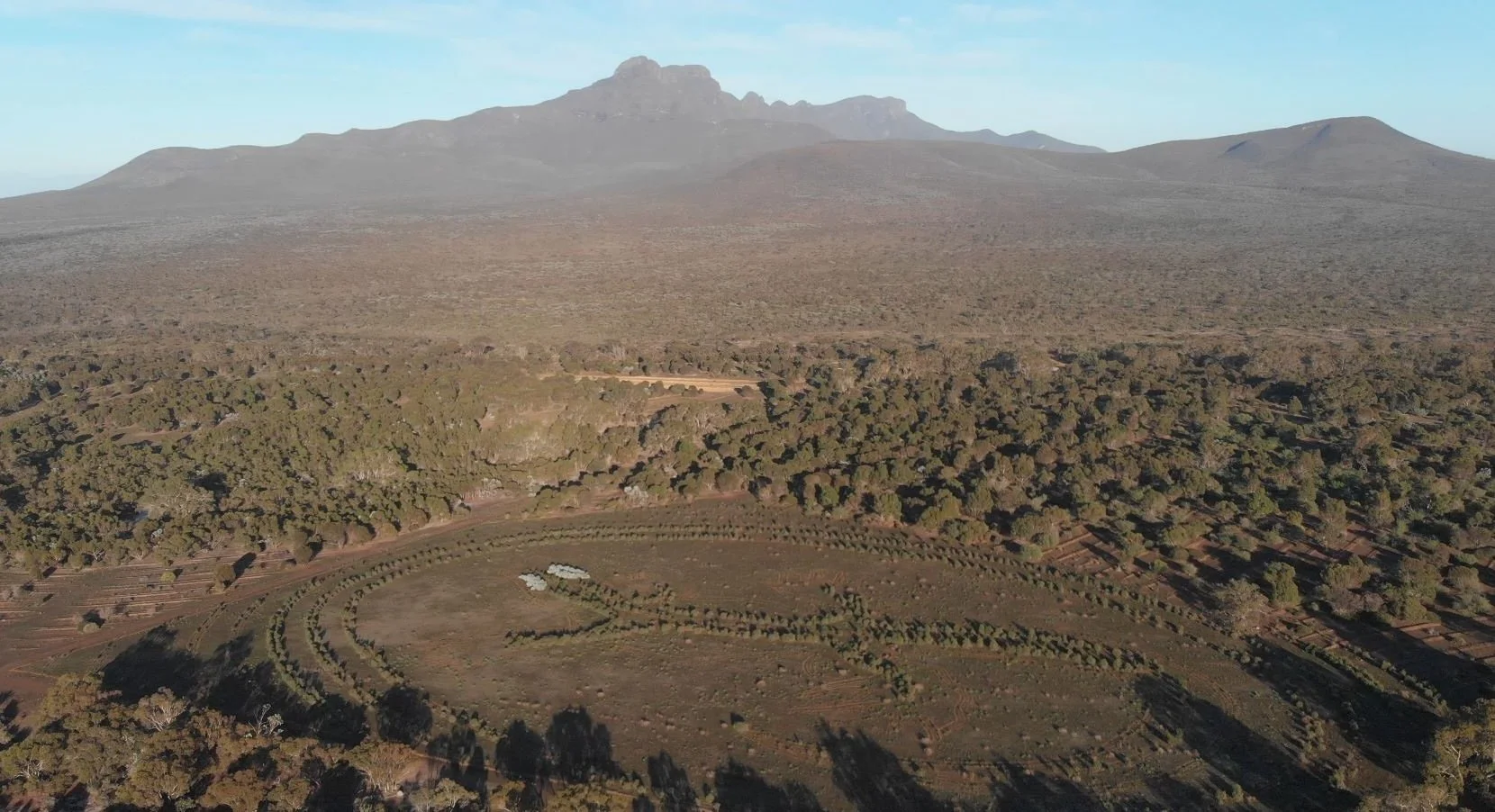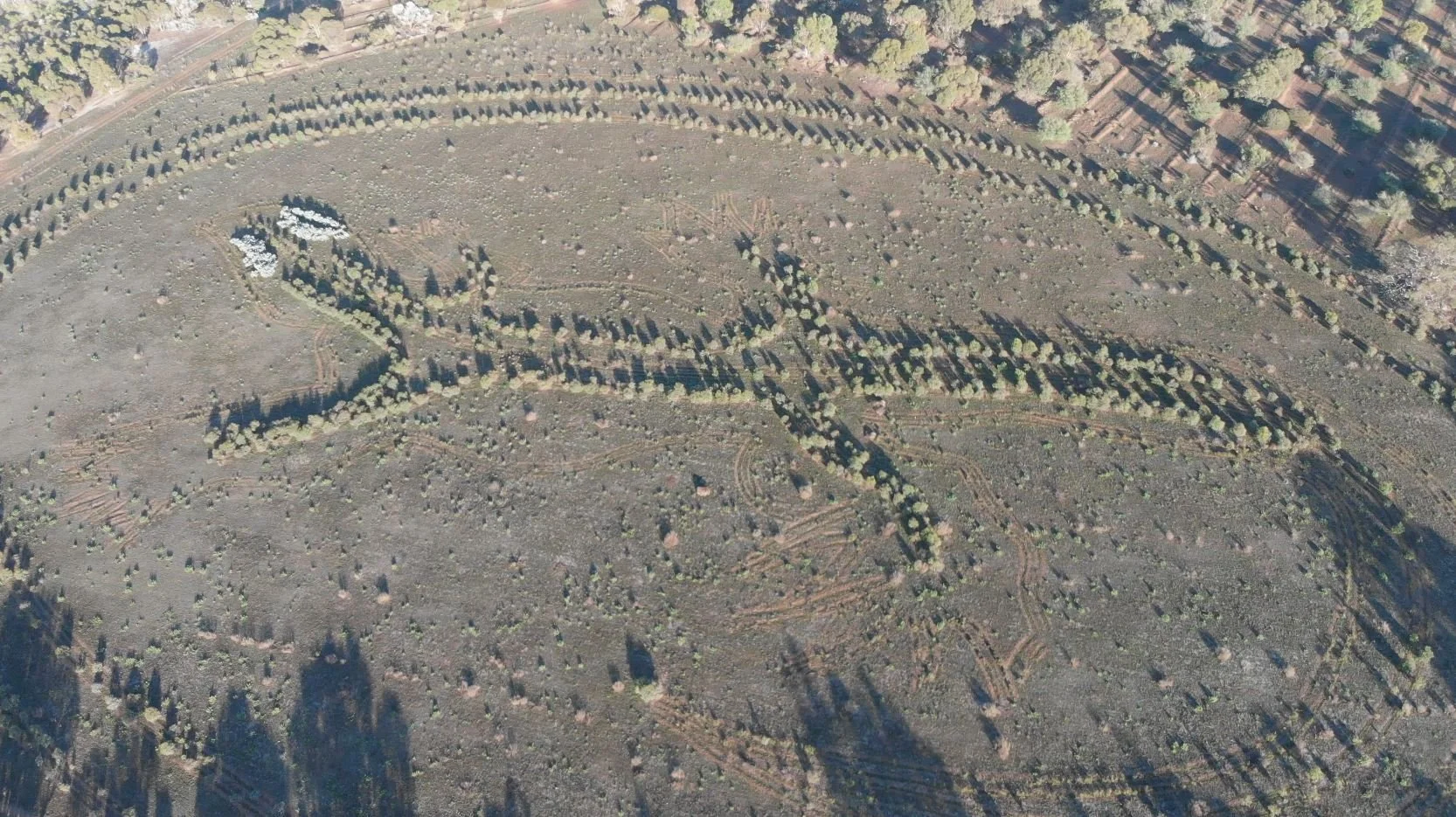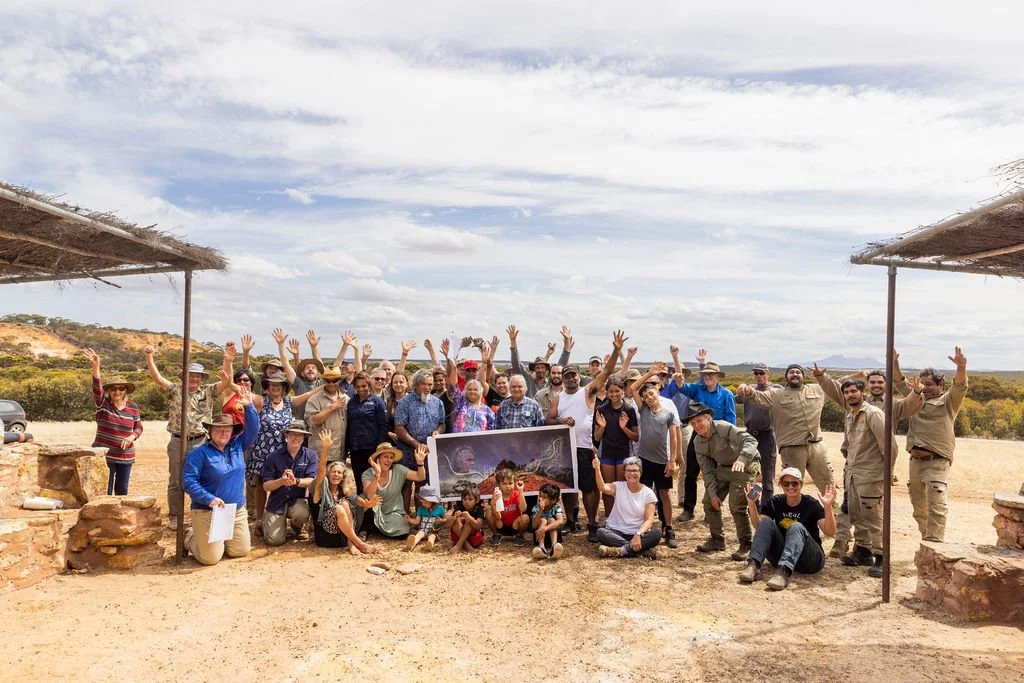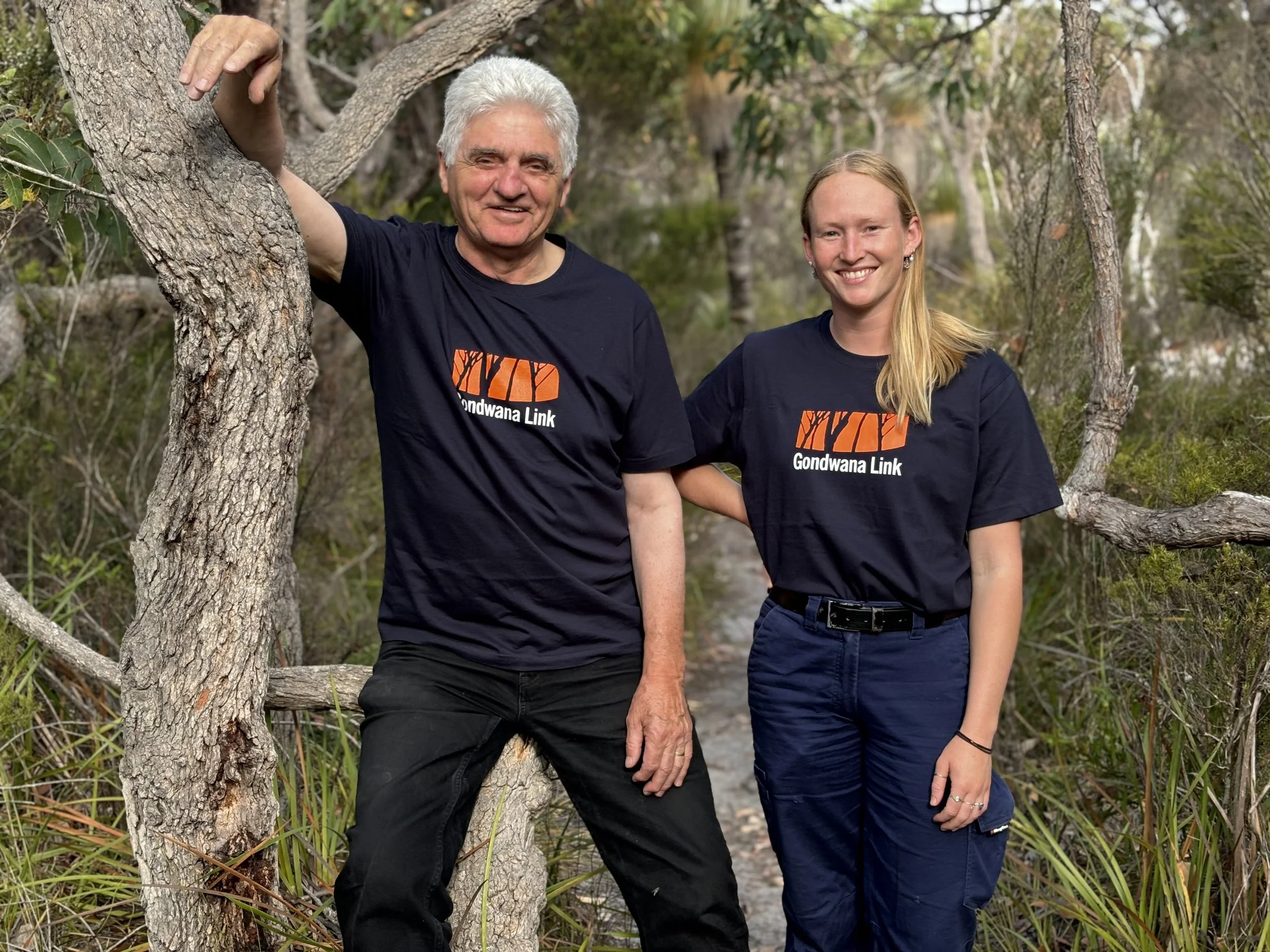Cleared Land to Gondwana Link: 1,000km of Restoration Across Global Biodiversity Hotspot
Published by The Biophilic Blueprint | Written by Anjelica Smilovitis, Founder
This story takes place on the traditional lands of the Noongar, Ngadju and Wongi peoples in Western Australia. We pay our respects to Elders past and present and acknowledge their enduring connection to Country, culture and community.
Young Keith Bradby in his element—the vast, biologically-rich natural area of the Fitzgerald River National Park. Photo: Courtesy of Keith Bradby.
When Keith Bradby first set foot in Western Australia in 1976, there was no sign of the 1,000-kilometre conservation legacy to come—especially in one of the planet’s richest biodiversity hotspots.
South-western Australia is one of the world’s first 25 biodiversity hotspots, celebrated for its extraordinary plant diversity and high levels of endemism (Myers et al., 2000; Brundrett, 2021). Yet a long history of land clearing, farming and settlement has fragmented ecosystems, left wildlife struggling, and disrupted First Nations’ stewardship of the land.
Thankfully, this is changing.
A 1,000km mindset shift has taken root—a biophilic vision where farming, livelihoods and communities can thrive alongside the wild, challenging the way we live with nature.
People are coming together to restore and maintain ecosystem function—from the wet forests of the south-west corner to the dry woodlands and mallee bordering the Nullarbor Plain.
Large-scale farms are joyfully witnessing wildlife return, bringing the benefits of biodiversity back to the land.
First Nations people are managing their land again, weaving ecological restoration with cultural connection.
And these efforts are shaping an ecosystem that nurtures both nature and people.
“It is one of the richest areas on the planet for biodiversity. To a biologist like me, this is the nearest place to heaven on earth … Gondwana Link is a fantastic program in the scale of its ambition, and the notion of trying to connect and restore from the south-west forests to the Great Western Woodlands is a very powerful idea.”
Photos left to right 2006, 2010 and 2019 show recreated bush link to the Stirling Range. The work is all about people caring for the land, reconnecting the bush and together making a difference. Photos: by Amanda Keesing and Blair Parsons. Courtesy of Gondwana Link.
Reimagining Country: The Gondwana Link Story
To get a closer look at the vision and the people driving this change, The Biophilic Blueprint spoke with Keith Bradby OAM, Chief Executive Officer of Gondwana Link about the active mission to reconnect Country—a link across traditional lands of the Noongar, Ngadju and Wongi people in South-western Australia.
Bradby tells The Biophilic Blueprint, when he first relocated from Victoria to Western Australia, he had plans to become a beekeeper. “It seemed like an honest way to make a living out in the bush,” he recalls, “but I didn’t really know what I was coming to.”
“Two things hit me in the face pretty fast,” Bradby recalls. “One was the amazing bush we have here in Western Australia which is like nowhere else on earth. The second was the sheer scale of destruction going on.”
That stark duality of beauty and loss would change the course of his life—and the south of Western Australia’s landscape.
Screening of Breathing Life into Boodja in Bridgetown, 2025. Photo: The Biophilic Blueprint.
Breathing life into Boodja
My first encounter with Bradby and the Gondwana Link community was at a screening of Breathing Life into Boodja in Bridgetown, in the Warren Blackwood region. The passionate way he spoke about the vision was contagious. And while the work itself blew me away, it was his courage—and that of everyone involved—that stayed with me. Their shared commitment to what once seemed a “wild idea” has sparked extraordinary regeneration and forged deep connections across people, places and cultures.
In a series of early encounters with scientists, new environmental perspectives and people on the ground, Bradby came to a pivotal moment in the sand outside the Pingrup Roadhouse, where a vision was first sketched more than two decades ago.
The Gondwana Link was established in 2002—and he has led the program since.
Bradby’s work on ecological restoration and landscape-scale conservation is nothing short of remarkable.
He has authored and co-authored numerous academic publications, written one book, and been involved in the production of two documentary films and several short videos. He worked directly for two State Cabinet Ministers and indirectly for a third across the political divide, including representing the WA Minister in developing the initial National Landcare Program.
As a public servant in the 1990s, Bradby managed and reformed the Peel-Harvey catchment program and drove the process that ended large-scale land clearing in south-western Australia. Bradby has also consulted on emerging large landscape efforts in New Zealand, southern Africa, and Mexico, and is a former Chair of the WA Landcare Network and former Deputy Chair of the National Landcare Network.
October 2002, Keith Bradby with Peg Olsen from The Nature Conservancy and Carol Binning from Greening Australia, planning some early steps in the Gondwana Link program. Photo: Angus Parker. Courtesy of Gondwana Link.
About the landscape: the history and the need for restoration
Across the South-western Australia, vast areas of land have been cleared. The short film Clearing the Land offers an insightful look into the State’s history—and the environmental challenges that the Gondwana Link initiative has been working to address on the ground.
A quote by New Frontier! 1967 sponsored by the Government of Western Australia and others said: “More than a million acres of new country is being turned into farms every year. Much of the land was useless sand plain, now made fertile by science and mechanisation.”
Native forest logging was also common—though in 2024 the Western Australian Government made the decision to end native tree logging to preserve approximately 400,000 additional hectares of karri, jarrah and wandoo forests.
Photos of 1940’s clearing of land, and 2016 map of Western Australia Generalised Land Use.
The science as a wake-up call: social and ecological apartheid
By the early 1980s, the science was stacking up. Climate predictions were already alarming and ecology was beginning to reveal the fragility of fragmented habitats.
“I personally got bound up in stopping or slowing that down,” Bradby recalls. “There was a lot of good science we bumped into in the early 80s, which showed us the urgency and need. It included, what was then called the Greenhouse Effect, but the predictions on how much the climate would change back then was pretty much what's happening now.”
Bradby encountered the concept of island biogeography, which highlighted the inevitable decline of species in small, isolated reserves. He recalled one example from the Wheatbelt reserves, which were then unlikely to “hang on” to their wildlife over time, as isolation would inevitably lead to species decline. “There was some nice work done in the Wheatbelt,” Bradby said, reflecting on the early conservation efforts.
But the phrase that truly shook him came from a CSIRO (Commonwealth Scientific and Industrial Research Organisation) scientist at a 1982 conference in Broken Hill. Bradby attended an Arid Lands Conservation conference and came across Earl Saxon.
“This smart young fella (Saxon) got up to talk about conservation reserves in Australia. He put up a map of all the inland big reserves and national parks—and a map of the homelands in South Africa—and talked about social apartheid and what a disaster it was. And then he talked about ecological apartheid,” Bradby told The Biophilic Blueprint.
“He (Saxon) absolutely nailed it for me. That's the vision I've carried since,” Bradby said.
Social apartheid refers to a policy or system of segregation or discrimination on grounds of race—most starkly seen in South Africa. Ecological apartheid extends this logic to the environment. Saxon argued that confining nature to fenced-off parks while the surrounding country was stripped bare was a form of segregation just as destructive as apartheid itself.
Bradby later revisited these ideas in his 1991 paper, A Data Bank Is Never Enough: The Local Approach to Landcare, building on Saxon’s work and laying out the early seeds of what would eventually become Gondwana Link. He called for “truly integrated” ecological care of Australian landscapes—beyond the narrow laneways of “corridors” that merely allow fauna to “scuttle” along, an approach he described as “absurd.”
He stated in the paper: “Over the past 200 years, the ecological unity of this continent has been shattered by the systems we presently use to produce both the basics and the luxuries of human survival. From the original small outposts of settlement surrounded by a sea of bush, we now have small outposts of bush surrounded by a sea of settlement and production.
“If the role of corridors is to restore the integrity of the Australian landscape and promote resilience in our ecosystems, the health of our landscapes, and the survival of rare species, then this involves much more than providing narrow laneways for fauna to scuttle along, under cover of darkness, from one oasis to another,” he writes in the paper.
Image: Gondwana Link.
Gondwana Link teams up with Annette Lees from Alternative Endings and a printed Strategy turned up in the mail.
A grand vision emerges—“the coalition of the willing”
By the late 1980s, Bradby was collaborating with local Landcare and National Park groups, where discussions began to evolve into visions of what might still be possible for environmental care.
“Sitting with the local Landcare and National Park groups, we realised we were in a part of the South west where there was a genuine chance of retaining what we once had,” he recalls. “It wasn’t until the late ’90s, however, that we could get serious about this—this being a grand vision.”
The Gondwana Link website describes the vision as: “We are reconnecting country across 1,000 km of south-western Australia—from the karri forests of the far south-west to the woodlands bordering the Nullarbor. Our vision is healthy, reconnected country where people live, work and thrive.”
From the very beginning, that hope was contagious says Bradby. “Within a month, an old colleague rang up and said they were going to buy some bush and wanted to buy in (to the vision). It was already starting to happen before we were ready for it. And it was fantastic.”
The early days were messy, improvised and profoundly human.
“There was a certain amount of useful naivety at the beginning,” Bradby laughs. “We recognised we had no idea how to structure what we were doing, but we just started to use that terrible phrase, a coalition of the willing — and started by doing.
“Far too often people think you've got to do complex plans. Well, the world's an untidy place, and every plan unravels.”
The guiding principles were simple: every action should matter in itself, and also contribute to a bigger change. Cooperation was—and is—the lifeblood.
“The small core group always worked with others. It became a vision with maximum cooperation,” Bradby said.
As the work grew, so did the stories of transformation.
Bradby shared story after story with The Biophilic Blueprint—and the scale of the work is immense. While we aim to capture some of the achievements, we can only scratch the surface of a movement that is so vast, deep, and transformational. For a true sense—and some genuine goosebump moments—of what has been accomplished on the ground, we highly recommend watching Breathing Life into Boodja.
Threshold Environmental’s Justin Jonson in 2008, with Sam Crowder and Threshold’s modified Great Plains direct seeding machine, about to start planting Yate woodland back onto Greening Australia’s Peniup property, near Jerramungup, in the Gondwana Link. Photo: Danny ten Seldam.
From bare paddocks to bush alive—and changed perceptions
One memorable moment Bradby shares is when a colleague from Victoria stood in a 60-hectare planting looking toward the Stirling Ranges on the horizon, and said, “Hey, it's actually happening, isn’t it? This is real.”
“It’s great to visit a bit of bush that wouldn't be there if you hadn't intervened,” Bradby reflects. “But to visit a bush full of wildlife that was once a bare wind-swept paddock is an extra boost.”
The work has echoed this—farmers delighting as birds returned to landscapes they had replanted. Across the Gondwana Link, farms have become testbeds for coexistence.
“We don’t have to choose between farmland and wildlife. By restoring Country in the right places, at the right scale, we can have both.”
Take Peter Luscombe, a farmer and ecological restoration pioneer located near Albany, who re-fenced his farm not just for stock, but for kangaroos and wallabies to move freely. Or Heather and Mark Adams, among the region’s biggest farmers between the Stirling and Porongurup Ranges, who have found joy in everyday encounters with wildlife.
Heather’s delight at spotting a rakali (water rat) on her property—captured in Breathing Life into Boodja—beautifully reflects this renewed relationship with the land.
Bradby shares the story of farmers near Bremer Bay who fenced and replanted wetlands across their cattle property—while continuing to run a successful operation. “And last year,” he says, “they saw chuditch return to the property.”
He explains that many farmers describe life as fuller since embracing the wild as part of their farming life.
“Life is so much richer when you're alert to the world around you—and a part of the world around you,” Bradby says. “Everywhere we look, people are working out how to live with wildlife and enjoying it. They get so much.”
Among the positive mindset changes is an embrace of culture—with First Nations people working alongside farmers to restore deep relationships with Country.
The Gondwana Link team worked extensively with the Ngadju people of the Great Western Woodlands, in 2015, visiting Fraser Range. Photo: Jane Bradley.
Photo: Drone shots of the Nowanup Rangers planting efforts of the Karda (goanna) on the Yarrabee property as it grew.
Cultural awareness on Country
The Gondwana Link program takes place across the traditional lands of the Noongar, Ngadju and Wongi people—and efforts to ensure First Nations leadership and participation in conservation continue to grow across the Link.
Bradby said that while the early focus was largely ecological, cultural awareness has deepened over time.
“We were very ecologically focused from the start,” he admits. The realisation that restoration was taking place on Country raised important questions for him: What does that mean, and how do we work with it? “There’s been an awareness, and then an acting on that new awareness several times as we’ve gone along,” he said.
Restored paddocks now being cared for by Traditional Custodians represent more than ecological recovery; they are sites of cultural continuity and healing.
In recent years, Native Title has been recognised over significant areas of public land. This restores important rights to Traditional Owners and opens the door to resume their roles as managers of the land.
Photo left to right: Nowanup Rangers, 2017, plant the Karda (goanna) on Yarrabee property. Members of the Yaramoup Aboriginal Corporation and Carbon Neutral colleagues on the Sunnyside property which Yaramoup now manage with family members living there. Photo: Courtesy of Gondwana Link and Amanda Keesing.
Urgency in a changing climate
For all the progress, Bradby is clear-eyed about the scale of the challenge.
“I wish we'd been able to move a lot faster and harder,” he admits. “Some of the work has been much slower in hitting the ground than I'd hoped, and I think the urgency is increasing on all fronts.
“The drying climate, the increasing incidence of wildfire, and the need for better management to stay ahead of these challenges — along with the purchase of key properties and replanting farmland—is now more than four times as expensive as when we started,” Bradby told The Biophilic Blueprint. “…And for the replanting, the seasons are a bit drier. So we really have to rev up and move faster.”
Despite the urgency, Bradby insists hope and inspiration are the engines of change.
For over a year, Gondwana Link has worked with CSIRO on a joint project, which will produce its first paper on the works, Bradby says.
“It’s pretty deep. The title focuses on the role of hope and inspiration in driving large landscape programs—and that’s exactly what it has been: a mixture of hope and inspiration.”
Toward a Biophilic future—A vision that belongs to all
Nearly 50 years since Bradby first arrived, Gondwana Link is alive across paddocks, wetlands, ranger programs and cultural sites. It is not his vision alone—it belongs to the communities, farmers, scientists and Traditional Custodians who make it real.
“Every time you do something on the ground, you know it's real,” he reflects. “And the more you've done on the ground, the more you can see it adding up to much bigger changes. Amongst all the ups and downs—and there have been a few downs—I've never doubted it was happening. The real questions have been: how well and how quick?”
Bradby laughs at his own optimism. “Sometimes you worry that you're just madly optimistic but I think we need to be.”
The story of Gondwana Link resonates far beyond Western Australia. It is a case study in what biophilic futures might look like: working with the land, not against it; farming with wildlife, not in spite of it; and building community resilience in the face of ecological crises.
As The Biophilic Blueprint continues to spotlight stories of regeneration and reconnection, Gondwana Link stands as one of the world’s most ambitious experiments in repairing landscapes at scale.
A thousand kilometres of vision—and counting.
References & Further Reading
About Earl Saxon on Ecological Apartheid. https://library.dbca.wa.gov.au/static/Journals/080341/080341-08.066.pdf
Bradby, K. (1991). A data bank is never enough: the local approach to landcare. In Nature Conservation 2: The Role of Corridors Retrieved from https://www.researchgate.net/publication/280325400_A_data_bank_is_never_enough_the_local_approach_to_landcare
Brundrett, M. C. (2021). One biodiversity hotspot to rule them all: Southwestern Australia—an extraordinary evolutionary centre for plant functional and taxonomic diversity. Journal of The Royal Society of Western Australia, 104, 91–122. https://doi.org/10.70880/001c.129578
Clearing of Native Vegetation in Western Australia by Sarah Sharman – Senior Environmental Specialist
Clearing the Land. Short film on land clearing in Western Australia. https://gondwanalink.org/clearing-the-land/
Breathing Life into Boodja. Short film on ecological and cultural restoration in WA. https://www.roninfilms.com.au/feature/17513/breathing-life-into-boodja.html
Gondwana Link. Biennial Report. https://mailchi.mp/ae5cc52fbda5/a-celebratory-gondwana-link-report-for-you-18248302
Heartland Journeys. Explore the places, people and nature across the Gondwana Link https://heartlandjourneys.com.au/
Gondwana Link. About & Projects. https://gondwanalink.org
Myers, N., Mittermeier, R., Mittermeier, C. et al. Biodiversity hotspots for conservation priorities. Nature403, 853–858 (2000). https://doi.org/10.1038/35002501
